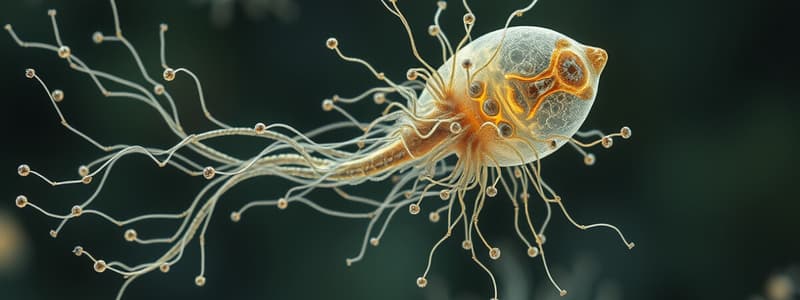Podcast
Questions and Answers
What causes swimming motility in prokaryotic cells?
What causes swimming motility in prokaryotic cells?
- Cytoplasm streaming
- Cilia
- Pseudopodia
- Flagella (correct)
Which of the following describes the structure of bacterial flagella?
Which of the following describes the structure of bacterial flagella?
- Straight and rigid
- Branching and multi-headed
- Helical with a uniform wavelength (correct)
- Flexible and coiled
What is the role of the proton motive force in bacterial flagella movement?
What is the role of the proton motive force in bacterial flagella movement?
- It creates torque for flagellar rotation. (correct)
- It powers the synthesis of flagella.
- It aids in the attachment of flagella to the cell.
- It maintains the structure of the flagellar filament.
In which type of flagellation are flagella located at one or both ends of the bacterial cell?
In which type of flagellation are flagella located at one or both ends of the bacterial cell?
What is the main difference between bacterial and archaeal flagella?
What is the main difference between bacterial and archaeal flagella?
How does the arrangement of flagella influence the swimming pattern of bacteria?
How does the arrangement of flagella influence the swimming pattern of bacteria?
What is the first step in the synthesis of bacterial flagella?
What is the first step in the synthesis of bacterial flagella?
What swimming pattern is typically associated with bacteria that have peritrichous flagella?
What swimming pattern is typically associated with bacteria that have peritrichous flagella?
What is gliding motility?
What is gliding motility?
Which mechanism uses the secretion of a slimy substance for movement?
Which mechanism uses the secretion of a slimy substance for movement?
How does the Type IV Pili Mechanism enable movement?
How does the Type IV Pili Mechanism enable movement?
What describes chemotaxis?
What describes chemotaxis?
In peritrichously flagellated bacteria, what movement occurs when they tumble?
In peritrichously flagellated bacteria, what movement occurs when they tumble?
What is true phototaxis?
What is true phototaxis?
Which type of taxis is specifically related to the presence of oxygen?
Which type of taxis is specifically related to the presence of oxygen?
What does the capillary tube assay measure?
What does the capillary tube assay measure?
Flashcards are hidden until you start studying
Study Notes
Introduction to Microbial Locomotion
- Motility enables prokaryotic cells to navigate their environments.
- Major prokaryotic cell movement types include swimming and gliding.
Swimming Motility
- Flagella, measuring 15-20 nm, facilitate swimming motility in bacteria.
Types of Flagellation
- Polar Flagellation: Flagella attached at one or both ends of a cell.
- Peritrichous Flagellation: Flagella dispersed over the entire surface of the cell.
Flagellar Structure
- Flagella are helical with a consistent wavelength.
- Components include:
- Tip
- Filament
- Hook
- Motor: Comprising L, P, MS, and C Rings.
- Mot proteins
- Fli proteins
Flagellar Movement
- Functions as a rotary motor allowing circular movement.
- Structure includes rotor (central rod and rings) and stator (mot proteins).
- Movement powered by the bacterial proton motive force.
Archaeal Flagella
- Have a width of 10-13 nm.
- Composed of various flagellin proteins and powered directly by ATP.
Flagellar Synthesis
- Begins with assembly of MS and C rings in the cytoplasmic membrane.
- Flagellin flows through the hook to form the filament; guided by cap proteins.
Speed and Motion Influences
- Speed and movement direction depend on flagella type and arrangement.
- Polar Flagella: Result in slow and linear swimming.
- Peritrichous Flagella: Cause erratic or tumbling swimming patterns.
Mechanisms of Gliding Motility
- Rod-shaped bacteria can glide without flagella, cilia, or pili.
Gliding Mechanisms
- Slime Extrusion: Secretion of a slimy substance for propulsion.
- Type IV Pili Mechanism: Involves retraction and extension of pili (e.g., Pseudomonas aeruginosa).
- Protein Adhesion Complex: Forms a sticky adhesion allowing movement (e.g., Myxococcus xanthus).
- Surface Protein Movement: Uses gliding-specific proteins for forward motion (e.g., Flavobacterium).
Chemotaxis
- Directed movement in response to chemical stimuli.
Differences in Chemotaxis
- Peritrichous Flagellated Bacteria: Exhibit runs (forward swimming) and tumbles (stopping and jiggles).
- Polar Flagellated Bacteria: Can reverse flagella rotation to change movement direction.
Measuring Chemotaxis
- Capillary Tube Assay:
- Controlled: No change in microorganism movement.
- Attractant: Microorganisms swarm towards chemical.
- Repellent: Microorganisms move away from chemical.
Phototaxis
- True Phototaxis: Movement towards increasing light intensity.
- Scotophobotaxis: Random swimming out of illuminated areas under a microscope.
Other Types of Taxes
- Aerotaxis: Movement towards or away from oxygen.
- Osmotaxis: Movement influenced by ion concentration.
- Hydrotaxis: Movement towards or away from water.
Studying That Suits You
Use AI to generate personalized quizzes and flashcards to suit your learning preferences.




